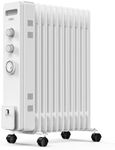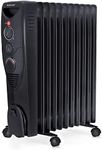Buying Guide for the Best Oil Filled Heater
Choosing the right oil-filled heater can make a significant difference in your comfort during the colder months. These heaters are known for their efficiency and ability to provide consistent warmth. When selecting an oil-filled heater, it's important to consider several key specifications to ensure you get the best fit for your needs. Understanding these specs will help you make an informed decision and find a heater that suits your space and heating requirements.Heating Power (Wattage)Heating power, measured in watts, indicates how much heat the heater can produce. This is important because it determines how effectively the heater can warm up a space. Generally, higher wattage means more heating power. For small rooms or personal spaces, a heater with 600-800 watts may suffice. Medium-sized rooms typically require 1000-1500 watts, while larger rooms or open spaces might need 2000 watts or more. Consider the size of the room you want to heat and choose a heater with appropriate wattage to ensure efficient heating.
Thermostat ControlA thermostat control allows you to set and maintain a desired temperature. This is important for energy efficiency and comfort, as it prevents the room from becoming too hot or too cold. Some heaters come with adjustable thermostats, while others have preset temperature settings. If you prefer precise control over the room temperature, look for a heater with an adjustable thermostat. For those who want simplicity, preset settings might be sufficient.
Safety FeaturesSafety features are crucial in any heating device to prevent accidents and ensure safe operation. Common safety features include overheat protection, tip-over switch, and cool-touch housing. Overheat protection automatically shuts off the heater if it gets too hot, while a tip-over switch turns off the heater if it is knocked over. Cool-touch housing ensures the exterior remains safe to touch. Prioritize heaters with these safety features, especially if you have children or pets.
Size and PortabilityThe size and portability of an oil-filled heater can affect its convenience and usability. Compact and lightweight heaters are easier to move around and store when not in use. Larger heaters may provide more heating power but can be cumbersome to relocate. Consider where you plan to use the heater and whether you need to move it between rooms. If portability is important, look for heaters with wheels or carrying handles.
Noise LevelOil-filled heaters are generally quiet, but some models may produce slight noise from the thermostat or heating elements. Noise level is important if you plan to use the heater in a bedroom, office, or other quiet space. If noise is a concern, look for models specifically advertised as silent or ultra-quiet. Reading user reviews can also provide insights into the noise levels of different heaters.
Energy EfficiencyEnergy efficiency refers to how effectively the heater converts electricity into heat. This is important for reducing energy consumption and lowering utility bills. Some heaters come with energy-saving modes or programmable timers that help manage energy use. Look for heaters with these features if you want to minimize energy costs. Additionally, consider the heater's wattage and how often you plan to use it to gauge its overall energy efficiency.
Heating Elements and DesignThe design and type of heating elements can affect the heater's performance and aesthetics. Some heaters have multiple fins or panels that increase surface area for better heat distribution. The design can also impact how quickly the heater warms up and how evenly it heats a room. Consider the design and number of heating elements if you want faster and more uniform heating. Additionally, choose a design that complements your room's decor if appearance is important to you.
















